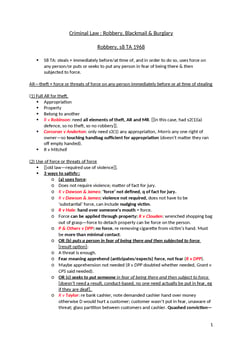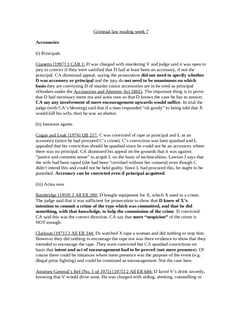R v Cheshire [1991] 1 WLR 844
Judgement for the case R v Cheshire
KEY POINTS
The Court rejected the defendant's argument and upheld the murder conviction. It was emphasised that the gunshot wound caused significant damage to the victim, leading to the necessity of a tracheotomy.
Although the medical intervention was an intervening act, it did not amount to a novus actus interveniens since the gunshot wound remained a substantial and operating cause of the victim's death.
For an intervening act to break the chain of causation, it must be so overwhelming and independent that it entirely removes the defendant's actions from the chain leading to death.
FACTS
The appellant shot a person who was later admitted to the hospital for treatment. As a result of the gunshot wound, the victim suffered breathing difficulties and required a tracheostomy tube to be inserted into his windpipe.
Approximately four weeks after the procedure, complications arose, leading to a narrowing of the windpipe, ultimately resulting in the victim's death.
During the trial, the judge instructed the jury that they should only acquit the appellant if they found the medical treatment provided to the victim was reckless, and thus the cause of his death. However, the jury convicted the appellant, finding him liable for the murder. The case was subsequently appealed to the Court of Appeal.
COMMENTARY
R v Cheshire underscores the importance of the "substantial and operating cause" test in determining causation in murder cases. The case reinforces the principle that a defendant may still be held liable for murder even if an intervening act plays a role in the victim's death, as long as the defendant's actions were a significant factor leading to the fatal outcome.
ORIGINAL ANALYSIS - FACTS
The appellant shot someone who went into hospital. He developed breathing problems and was given a tracheostomy tube in his windpipe, which four weeks later caused a narrowing of the windpipe and the victim died.
The judge told the jury to acquit only if the medical treatment was reckless.
They convicted him and the CA rejected his appeal.
ORIGINAL ANALYSIS - JUDGEMENT
Whether or not the medical treatment was an operating and substantial cause depends on whether the treatment was actually reckless, not just negligent.
The judge says that just because competent intervention by a doctor that has failed will not amount to an intervening case, this does not mean that all treatment below that level of competence is an intervening case. He quotes Hart as saying that poor treatment is too common to be treated as abnormal.
It will only be in the most extraordinary and unusual case that such treatment…could be regarded in law as the cause of the victim’s death to the exclusion of the defendant’s acts.
The above doesn’t answer what these situations are. Not sufficient as explanation.
ORIGINAL ANALYSIS - COMMENTARY
Harming someone is a negative process, whereas healthcare is a rectifying one, so that merely because healthcare fails to solve the problem inflicted by harms, doesn’t stop the harmful act being operative. Healthcare should be viewed as undoing an action, not an action in itself. If it were true that healthcare could be viewed as relevant, then violent criminals who live in countries with a high standard of healthcare could claim to be less liable than those in countries with poor or no healthcare (murder was still murder before the NHS was created).
-
Only if the medical treatment was so bad as to have a negative impact (or as the judge puts it, “reckless”) on the victim, or was unrelated to the wound inflicted by the criminal (for example if a doctor drops a machine on a patient’s head during surgery, causing immediate death), can we really call it an intervening act.
This is because if it merely fails to prevent death from the wound it is simply a neutral action.
One test we could apply to decide at what point the healthcare has become an intervening act would be to look at whether the consequence is a natural one of the action in question. E.g. if I accidentally cut my finger and when getting it stitched up in hospital I contract MRSA and die, the verdict would not be suicide.
However if I stab someone and during the operation a mistake causes them to bleed to death, then the stabbing would still be operative because death from a stab wound is clearly a possible consequence.
In this case the physical cause of death came about in an operation attempting to repair damage done (the tracheotomy was immediately subsequent to the attack) and clearly medical care was not so bad as to be considered reckless since they did actually manage to sustain his life for four weeks.
The fact that they didn’t do as much as they could is irrelevant due to the argument in paragraph 1 of this section.
For Further Study on R v Cheshire

A collection of the best GDL notes the director of Oxbridge Notes (an O...
Need instant answers? Our AI exam tutor is here to help.
Ask questions 🙋 Get answers 📔 It's simple 👁️👄👁️
Our AI is educated by the highest scoring students across all subjects and schools. Join hundreds of your peers today.
Get StartedRelated Product Samples
These product samples contain the same concepts we cover in this case.
| Criminal Law | Actus Reus — Omissions And Causation Notes (25 pages) |
| GDL Criminal Law | Causation Notes (7 pages) |
| Criminal Law | Homicide Notes (20 pages) |

 Since 2010, Oxbridge Notes has been a trusted education marketplace, supplying high-quality materials from top achievers at universities like Oxford, Cambridge, LSE, Harvard, and Yale.
Since 2010, Oxbridge Notes has been a trusted education marketplace, supplying high-quality materials from top achievers at universities like Oxford, Cambridge, LSE, Harvard, and Yale.